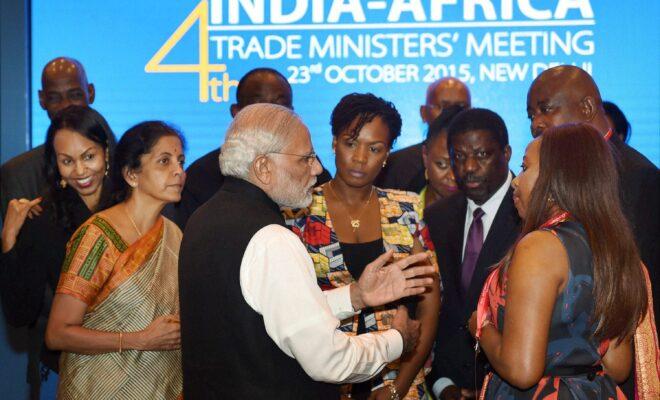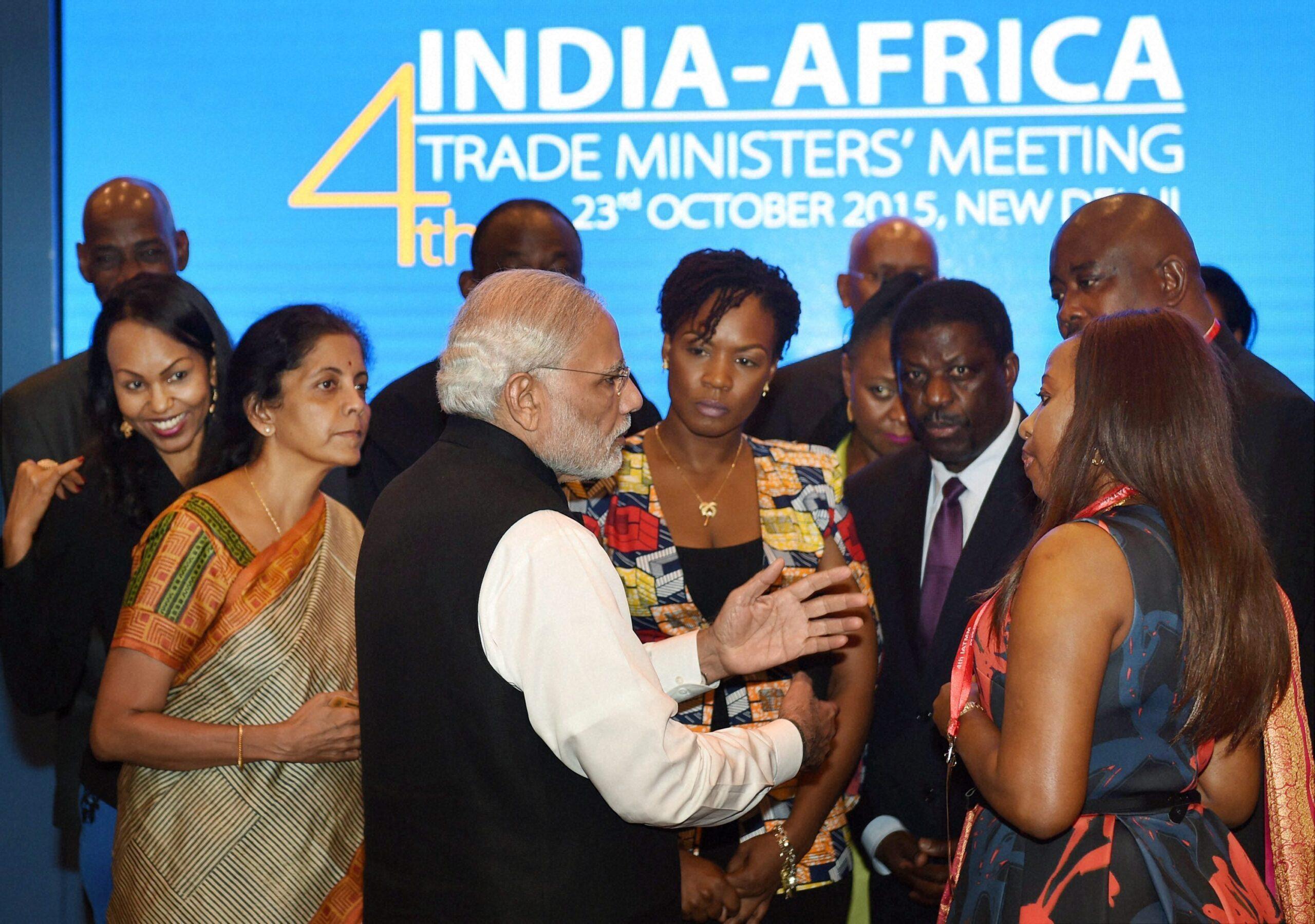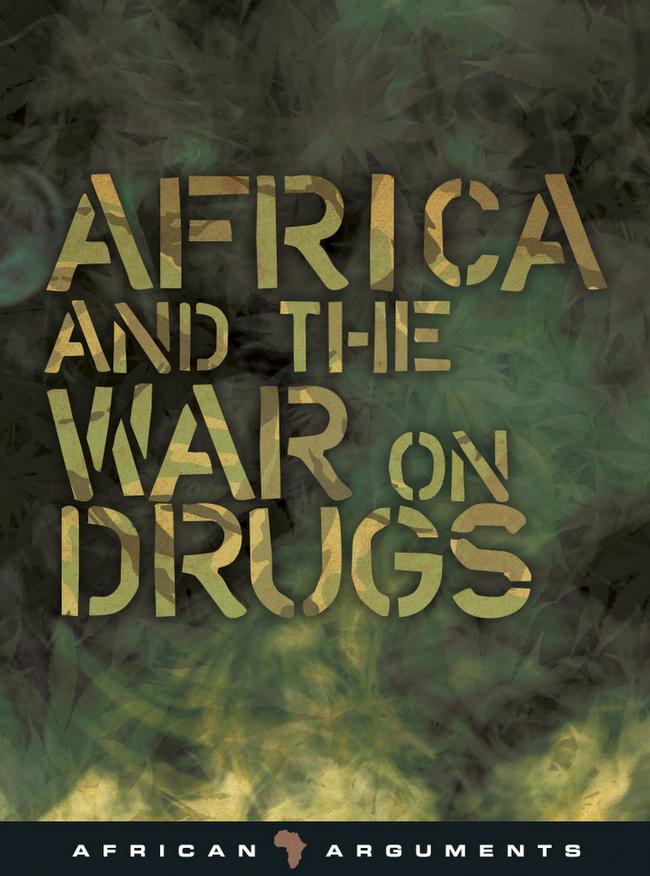
Debating Ideas aims to reflect the values and editorial ethos of the African Arguments book series, publishing engaged, often radical, scholarship, original and activist writing from within the African continent and beyond. It offers debates and engagements, contexts and controversies, and reviews and responses flowing from the African Arguments books.

Prime Minister Narendra Modi talks with the delegates of African countries before a dinner at the India-Africa Trade Ministers in 2015. Credit: PTI
With the goal of playing a more influential role in world affairs, a key foreign policy strategy for New Delhi has long been its aid and investment policies abroad. The African continent has always featured prominently in India’s development diplomacy, given that support from African countries is crucial for India’s long-standing campaign for a permanent seat on the UN Security Council. As more Indian firms seek to establish a global presence, access to African markets is also important. Couched under the banner of South-South cooperation, which aims to provide a framework for collaboration between postcolonial nations at a similar stage of development, India has since independence in 1947 facilitated the exchange of knowledge, technology and experiences to Africa. Originally conceived as a partnership between equals, India’s Africa strategy continues to be described by Indian officials as a ‘demand-driven’ exercise, with ‘win-win outcomes’ and ‘mutual benefit’ for both India and African nations. In doing so, India is careful to distance itself from the inherent hierarchies that characterise North-South cooperation and the aid architectures associated with former colonial powers.
For decades, capacity building has been at the heart of India’s engagements in Africa. Scholarships were offered to students wishing to pursue university degrees as well as short-term technical training courses. Much like China, although to a much smaller extent, concessional loans for development projects disbursed directly to a recipient country have also featured prominently in India’s strategy. Since the 1950s, the Indian army has been one of the largest contributors to UN peacekeeping efforts on the continent. But, as it sought to increase its influence overseas following neoliberal reforms in 1991, New Delhi’s ideologically-charged goals gradually gave way to a more pragmatic exercise shaped increasingly by economic and geopolitical priorities. While it significantly scaled up its development cooperation with African countries the modalities of this exercise changed. Our ongoing study of India’s growing footprint in Africa finds five major changes to this Indian model: the emergence of new financial mechanisms; the active role of business associations and private sector actors; greater involvement of civil society organisations and sub-national actors; an emphasis on triangular cooperation; and greater priority to partner with multilateral organisations.
First, new financing mechanisms developed by India in recent years are more commercial in nature as interest rates are higher and the grant element is smaller than the Lines of Credit offered in the past. The Export-Import (EXIM) Bank of India now offers Buyers’ Credit to foreign governments for the purchase of additional goods and services for projects funded by India. Large public sector banks, like State Bank of India and Bank of Baroda, also provide concessional finance for Indian companies to operate abroad, as well as commercial loans to a range of stakeholders in the geographies in which they operate. With the commercialisation of development finance, India’s development cooperation has changed from a partnership between equals to a more hierarchical relationship between the country and its African allies.
Second, the private sector is playing a more active role. The Confederation of Indian Industry (CII) and the Federation of Indian Chambers of Commerce (FICCI) routinely lobby Indian and African governments, and are instrumental in connecting small and middle enterprises from India with stakeholders on the continent. These organisations advocate Public-Private Partnerships as the preferred modality of Indian investments and work closely with the Ministry of Commerce, EXIM Bank of India and the Ministry of External Affairs. A good example is the CII-EXIM conclave on Africa, first held in 2005, which helps Indian businesses establish and grow their footprint in Africa. While the India Africa Forum Summits (IAFSs), the official platform for strengthening India-Africa relations, have only been held on three occasions, there have been 17 business conclaves to date. Major Indian multinationals now established in African markets, such as the Tata group, Jindal and Mahindra, have developed in-house training programmes for local staff and have stepped up their Corporate Social Responsibility commitments.
Third, while India’s development cooperation strategy before 1991 was largely a state-controlled exercise, non-state actors are now playing a more active role. Civil society organisations are more involved in capacity-building initiatives. While the Self-Employed Women’s Organisation (SEWA) offers training modules on small-scale agriculture, Barefoot College in Rajasthan offers training in solar energy technology to their African partners. In addition, the state governments of Punjab, Haryana and Gujarat are courting African stakeholders directly in a bid to strengthen cultural and economic ties, and enhance trade and investments in sectors as diverse as agriculture and defence. This points to the rise of para-diplomacy and the decentralisation of India’s African strategy, which in future may be increasingly determined by state governments and shaped by regional Indian interests.
Fourth, India, like China, is emphasising triangular cooperation, which seeks to involve a myriad of actors such as governments, CSOs and business forums, from both the Global North and Global South. Illustrative examples include the Asia-Africa Growth Corridor (AAGG), conceptualised by Japan, India and several African countries for improvements in infrastructure and digitalisation; Supporting Indian Trade and Investments in Africa (SITA) funded by the United Kingdom’s Foreign Commonwealth and Development Office; and the Future India Triangular Training (FTF-ITT) Programme funded by USAID and India for agricultural research in Africa.
Fifth, India’s financial contributions to the multilateral system have steadily increased from 2006 to 2018. These funds are typically channelled through regional development banks, UN agencies and the World Bank. This is in tune with India’s self-perception of itself as a leader of the Global South, and also reflects the country’s long-standing campaign to make the current multilateral order more inclusive of voices of developing nations.

Credit: PTI
The rise of India and China and other donors from the Global South has created a polycentric global landscape, providing African policymakers with viable alternatives to the Global North. However, we find that over the years there has been a gradual convergence of strategies, practices and rhetoric employed by Northern and Southern donors. While promoting models which incorporate blended finance into their aid regimes in novel ways, various Indian entities have sought to adopt technical and operational policies from the OECD/DAC and the World Bank. In the process, India’s development cooperation with the African continent has gradually become synonymous with its economic diplomacy, as foreign policy is crafted to boost trade, investment and stimulate the overseas growth of Indian industries. These changes have been accompanied by a new ideological framework, couched in the idea of Indian Exceptionalism, which is radically different from the idea of South-South cooperation. In our subsequent piece, to run also on Debating Ideas – African Arguments, we discuss how Indian Exceptionalism informs the country’s African engagements and shapes its economic diplomacy approach.
This piece results from a collaborative research project entitled ‘India’s Footprint in Africa: South-South Cooperation and the Politics of Gifts and Reciprocity’, funded by the Research Council of Norway.






To enhance partnership opportunity , ensures development growth in communities